Join us as we rewind time back to Scotland during the 18th century, a time when none other than Walter Scott, literary genius and passionate Scot, was born.
Experience life in Scotland several centuries ago through the eyes of Walter Scott and read about certain events that have become intricately woven with Scottish history as we know it… and why his life was nothing short of amazing.
Walter Scott Bio
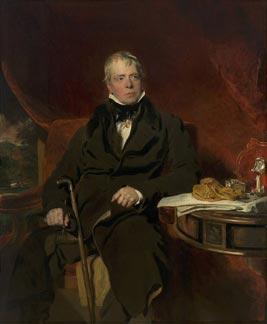
Where else to begin but at the start? Walter Scott was born in Edinburgh on the 15th of August, 1771. With a lawyer father and a mother in the medical profession, Scott was destined to go on and do great things, which we now know he managed to do.
Scott was educated at the High School in Edinburgh and also at the Grammar School in Kelso.
His interest in Scotland, especially surrounding the country’s history, started at a young age when he would listen to stories and tales recited by his relatives. These events would go on to shape his career in future years.
A significant year in his life was 1797 when he married Charlotte Carpenter, a member of a French family, to whom he remained married and had four children, up until his death 29 years later in 1826.
Abbotsford the home of Sir Walter Scott
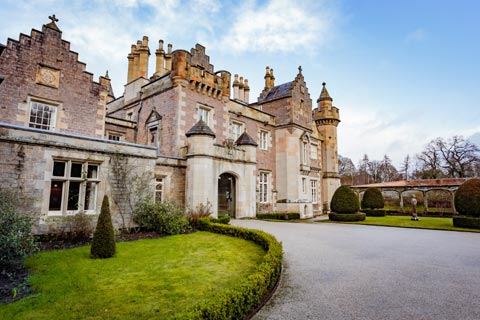
Walter Scott bought a farm that he named Abbotsford, situated in the Scottish Borders, an impressive building similar in design to some other well-known Scottish locations. Previously called Cartleyhole (or Newarthaugh on the deeds), Walter Scott put his own stamp on the place. He had even started carrying out “home renovations” before it was officially his by planting some trees.
Open to visitors, you may find some areas of the house look familiar – a glimpse at the garden screen wall drew inspiration from Melrose Abbey (the cloisters, to be exact), whilst the library features plaster casts that were taken from Rosslyn Chapel.
The library is also home to thousands of books and some gems that are little pieces of Scottish history – even including a lock of hair from Bonnie Prince Charlie.
Novels by Walter Scott
It is almost impossible to think about Walter Scott without thinking about his novels. His writing career began with poetry before developing into novel writing focused on Scotland. His first book was titled Waverley, regaling stories surrounding the Jacobite Rebellion. Interestingly, this novel was published anonymously to allow him to “test the waters”. However, it turned out there was nothing to worry about – his foray into becoming a novelist was a success and paved the way for many more books.
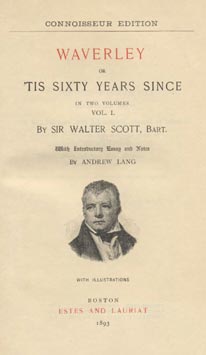
The Waverley novels became a series that inspired a range of Scottish buildings and landmarks, including Waverley Station Edinburgh and the Paddle Steamer Waverley, which sails passengers across the Firth of Clyde and throughout the waters of the British Isles. So next time you book a train ticket to “Edinburgh Waverley”, think of Walter Scott, the man behind the name!
His later works moved beyond Scotland and tackled topics further afield, both in the UK and abroad. His novel Ivanhoe was based in England, whilst The Talisman took inspiration from Palestine, published a few years later in 1825.
To this day, the Walter Scott classics remain popular with readers – after all, they aren’t called classics for no reason.
Walter Scott – Notable Events
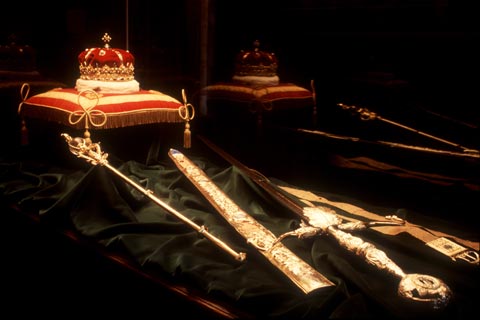
Aside from his novels, Walter Scott is often thought of synonymously alongside several historical events. He was the one who rediscovered the Scottish Crown Jewels in 1819, also known as the Honours of Scotland, at Edinburgh Castle, stored safely in an old chest where they had sat since the beginning of the 1700s.
Following instructions from King George IV, finding the very jewels that had been used for King Charles II cemented Walter Scott in the history books… and resulted in him being made a baronet and becoming Sir Walter Scott.
You can see these jewels for yourself in the Crown Room at Edinburgh Castle – why not book a seat on one of our tours and tour the castle in style?
Visit of King George IV
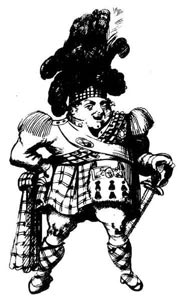
Back in Scotland in 1822, a royal visit from George IV, the first by a reigning monarch in over 200 years, was orchestrated by Walter Scott. The King wore tartan during the visit, which had been forbidden since the 1746 Jacobite uprising of Bonnie Prince Charlie. The outfit worn by the King was a far more colourful and dressier affair than the traditional tartan fèileadh-mòr worn by the highlanders. Even more so with the addition of bright pink leggings, which the monarch wore to complete the ensemble!
The visit of George IV also resulted in the return of the cannon, Mons Meg, which at the time was located in London. This impressive weapon is one of the many attractions on display at Edinburgh Castle.
Sir Walter Scott Monument in Edinburgh
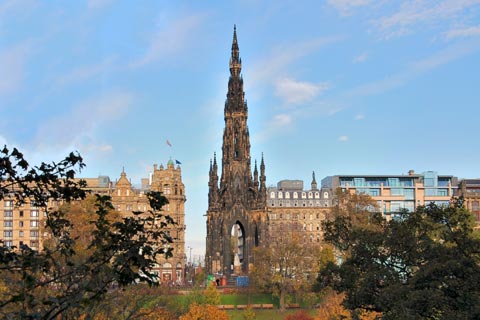
Did you know that you can see Walter Scott when you visit us in Scotland? Two monuments exist, one of which is in his hometown of Edinburgh on Princes Street – Princes Street Gardens, to be precise.
Towering 61 metres (200 ft) there are 287 steps to the top where a viewing gallery provides a birds-eye view of Edinburgh and the surrounding countryside.
At the foot of the Scott Monument sits a statue of the man himself and his dog, Maida. In a fitting tribute to his writing career, the surrounding spires are adorned with figures from his novels.
The monument was built following the death of Scott in 1832. Its gothic design is thanks to George Meikle Kemp, who won the competition to build a fitting memorial to this outstanding literary genius.
Sir Walter Scott Monument George Square Glasgow
The monument to Sir Walter Scott in Glasgow was actually the first one to be built and can be found in the city’s centre in George Square. You’ll see Walter Scott shrouded in plaid sitting atop a Doric column – a truly fitting tribute to this Scottish novelist.
Scotts View
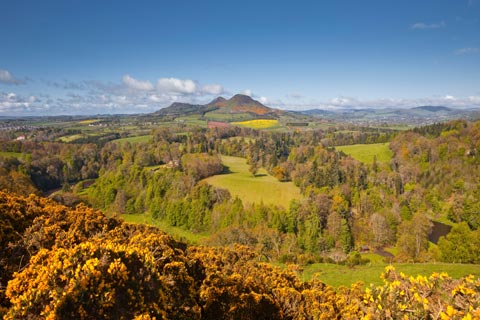
Located in the beautiful Scottish Borders, not far from his treasured Abbotsford, is a beauty spot named Scott’s View as a tribute to this great Scottish novelist. It’s said that the author used to sit and take in the vista of the River Tweed and Eildon Hills.
Legend has it that Scott visited here so often that his horse would stop at the viewpoint without a command. When his funeral cortege made the journey to Dryburgh Abbey, Scott’s resting place, the horses automatically stopped to allow their master one final look at his beloved Border scenery.
Explore Scotland with Scottish Tours
Sir Walter Scott was one of the pioneers of Scottish tourism. His poems and novels vividly described the beauty and traditions of Scotland, which captured travellers’ imagination in the early 1800s.
You can discover Scotland’s natural beauty on one of our sightseeing tours from Edinburgh, Glasgow, Inverness and London.
Discover our range of Scotland Tours today.

